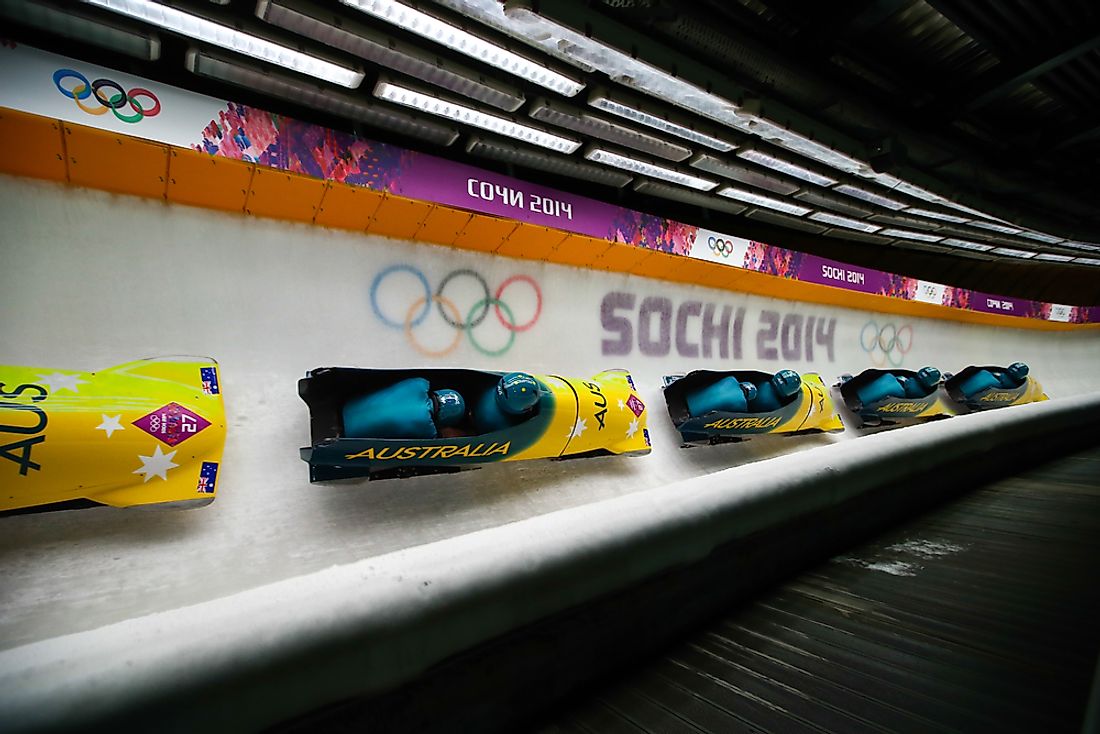Winter Olympic Games: Bobsleigh

Bobsleigh is a winter sport characterized by runs that are timed and go down narrow, twisting, banked, iced tracks using a sled that is motorized by gravity. The final score is a calculation of the timed runs. The name "bobsleigh" was derived from a technique that the competitors used, and the players would bob back and forth while inside the sled to accelerate speed.
The Event
Bobsleigh is a tournament that takes place during the Winter Olympic Games in which a team of either two or four people drives a sled that is specially designed to run down a track coated with ice. The team that competes on the track route with the fastest time emerges as the winner. The first bobsleigh event took place in 1924 during the very first Winter Games, in Chamonix France. However, to avoid expenses, the event was not featured in the 1960 Winter Olympic Games in Squaw Valley since the organizing committee opted not to have a track built. Besides the exception, participants of the bobsleigh event have competed in every game organized ever since. A two-man event was first introduced in 1932, while in the year 2002, at the Winter Olympics a two-woman event was introduced.
History
Bobsleigh is among the five original sports at the Winter Olympic Games. Initially, winter games were held after a four-year period between 1924 and 1936. The Winter Olympic Games did not take place in 1940 and 1944 due to the Second World War but later resumed in the year 1948. However, in 1992, the International Olympic Committee (IOC) decided to have the games take place alternating every two years between the Winter and Summer Olympic Games. Despite sledding on ice or snow being popular in most northern countries, the sport itself only originated a few decades ago. Bobsleigh evolved from two skeleton sleds being connected with a board; a steering mechanism was appended to the front part of the sled. Although the initial formal races took place on roads covered by snow, formal bobsleigh competitions were held at St Moritz in 1884.
Different Governing Bodies
International bobsleigh competitions are governed by the International Bobsleigh and Skeleton Federation, also the French Fédération International de Bobsleigh et de Tobogganing (FIBT). On the other hand, national competitions are governed by Bobsleigh Canada Skeleton and the United States Bobsled and Skeleton Federation. The FIBT was established in 1923. Bobsleigh popular events include European and American championships as well as the World Cup championships. Regarding overall success in the World, Olympic, World Cup, and European championships, both Switzerland and Germany have demonstrated that they are the nations to beat. However, the Germans have managed to dominate bobsleigh international competitions by taking the lead since the 1990's. Compared to other countries, the Germans have won more medals over the years. Other nations that have strong bobsleigh customs include the US, Austria, Canada, and Italy.
Bobsleigh Tracks
The modern bobsleigh tracks are built out of cement which is then coated with ice, with a requirement of one labyrinth and at least one straight section. A modern bobsleigh track is supposed to be about 3,900 to 4,300 feet-long with at least fifteen curves. In different countries like Latvia, Canada, Italy, Norway, and France tourists are offered bobsleigh rides. The Petersen is the most famous of all turns; it is a renowned trademark for its 108 degrees and 270 degree bank angle, which was named after pioneer track designer Heidi Petersen. Several bobsleigh tracks are also used for skeleton and luge competitions.











